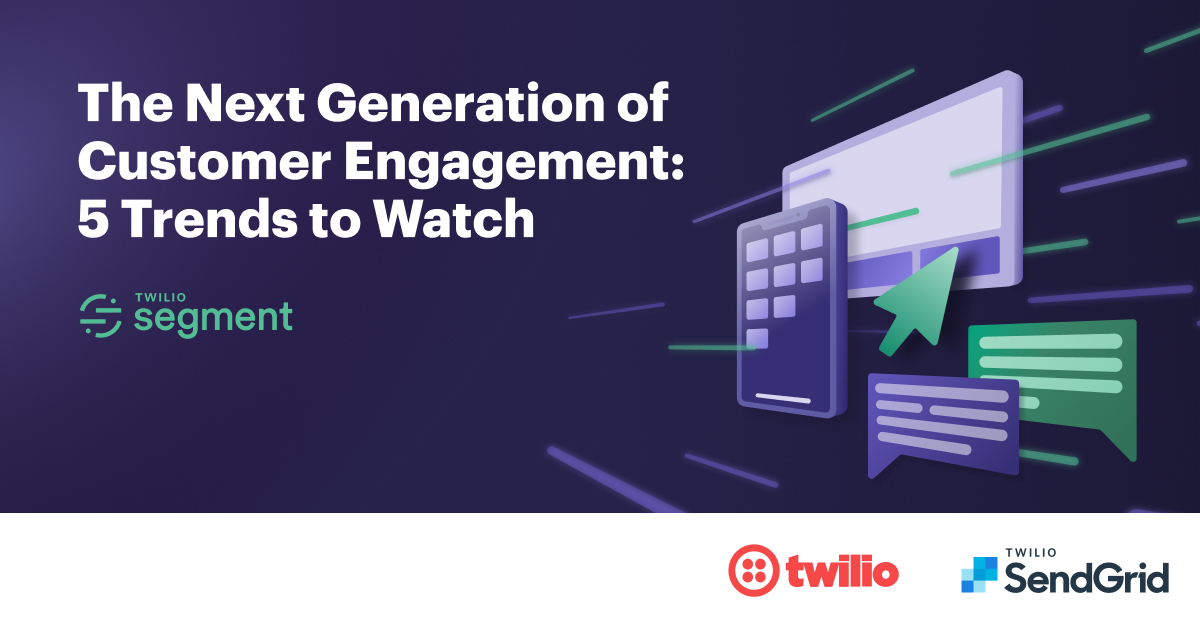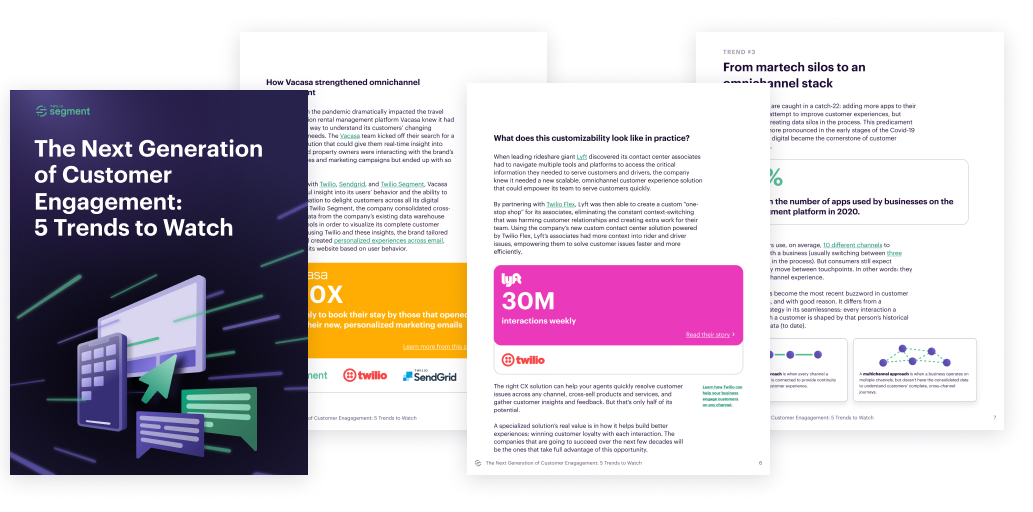Just Launched: The Next Generation of Customer Engagement: 5 Trends to Watch
Time to read:
This post is part of Twilio’s archive and may contain outdated information. We’re always building something new, so be sure to check out our latest posts for the most up-to-date insights.

The last year and a half have changed the way we engage with our customers. Businesses that historically relied on in-store experiences had to shift to an online strategy, resulting in unprecedented rates of digital transformation and user adoption. But now, as we’ve settled into our “new normal,” it’s time to look forward and see what the future holds.
That’s why we created The Next Generation of Customer Engagement: 5 Trends to Watch, our latest guide from Twilio Segment and Twilio SendGrid. In it, you’ll find the top 5 trends our team’s experts expect to shake up the way businesses serve and engage customers in 2021 and beyond.
Here’s a sneak peek at the trends we foresee will determine how customer relationships evolve, and what will ultimately determine a company’s success.
1. Tackling data volume
With every tap, scroll, click, and purchase our users make, the amount of data we collect from our users and customers continues to grow. Our State of Customer Engagement Report 2021 even found that 90% of businesses reported that customer insights increased as a result of greater digital engagement during the pandemic. Plus, we expect to reach more than 180 zettabytes of global data by 2025.
While it’s incredible that we have so much customer data at our fingertips, it’s becoming increasingly more difficult to sort through the sheer volume of information and isolate the data that can help your brand become more strategic about its engagement strategy. That’s why marketing teams need the right tools to:
- Access customer data without depending on other teams
- Cut through the noise and zero in on actionable insights
- Unify your customer’s touchpoints across all platforms and channels
This not only allows your business to create a single view of your customer, but it also democratizes your data, making it easier for every employee to access and pull the data they need without having to pester your engineering and data science teams. Armed with that data, all of your internal employees can make better, more informed decisions. That, in turn, will allow your marketing teams to build high-quality, personalized experiences that engage customers at exactly the right time in their journey.
2. Investing in flexible and customizable systems
The customer experience (CX) will be one of the key competitive differentiators in the coming years. After all, if you're not offering something unique, then why should customers choose to engage with your brand over another?
But, when you partner with one-size-fits-all customer service and engagement tools, you’re offering what every other business on the market is. That’s why more and more businesses need to invest in developer-first solutions that give them the building blocks to create systems that meet every business need, rather than forcing them to compromise on form and functionality.
The real value of a specialized cloud contact solution, like Twilio Flex, comes from its ability to empower your brand to build better customer experiences, delight your users with every interaction, and ultimately earn their loyalty. The companies that are really going to succeed over the next few decades will be the ones that acknowledge this opportunity, invest in the right systems, and set themselves apart as experts of CX.

3. Creating an omnichannel tech stack
In the last year, there’s been a mad scramble to get your business on every single channel that your customers use and interact with on a daily basis, like email, SMS, video, voice, chat, and more. While a multichannel approach is a good idea, in theory, it often creates data silos and disjointed customer experiences. Instead, businesses need to invest in creating omnichannel experiences that provide continuity and personalization for consumers—no matter where they decide to interact with your brand.
But despite most companies’ interest in building an omnichannel communications strategy, very few have been able to pull it off—only 24% of businesses admit to successfully investing in omnichannel personalization. In order to make an omnichannel strategy a reality, businesses need to embed a scalable data infrastructure into operations to centralize customer data and act on it in real time. This, in turn, creates hyper-personalized experiences based on customer demographic, interest, and behavioral data.
---
Sorting through data at volume, investing in flexible developer-first tech solutions, and embracing omnichannel are just a few of the emerging trends we mention in our new guide: The Next Generation of Customer Engagement: 5 Trends to Watch. For even more cutting-edge CX developments and tips on how to stay ahead of the curve, download the full guide here.
Related Posts
Related Resources
Twilio Docs
From APIs to SDKs to sample apps
API reference documentation, SDKs, helper libraries, quickstarts, and tutorials for your language and platform.
Resource Center
The latest ebooks, industry reports, and webinars
Learn from customer engagement experts to improve your own communication.
Ahoy
Twilio's developer community hub
Best practices, code samples, and inspiration to build communications and digital engagement experiences.


